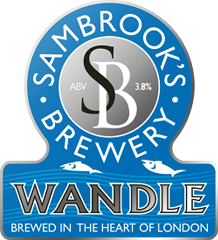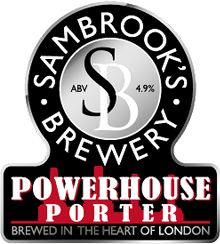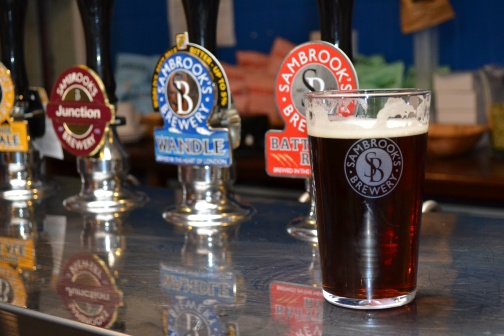When we meet up with Duncan Sambrook, the founder and Managing Director of Sambrook’s Brewery, he is still reeling from a Scandinavian takeover of the brewery bar. The previous evening a gathering of fifty Danes downed an astonishing four firkins – nearly three-hundred pints – of their seasonal Battersea Rye ale. They have also, it transpires, pinched his bottle opener.
Despite the Scandi marauding, Duncan is in good spirits as he welcomes us to the brewery in Battersea, south west London. Sambrook’s is one of the more mature players in the recent London brewing boom, and has just celebrated its fifth birthday with an event at Morden Hall Park, Beer by the River. Unlike many of the trendy craft breweries popping up almost weekly in east London, Sambrook’s has a more traditional image, brewing a small but popular range of cask ales and supplying around 300 London pubs.
When Sambrook’s launched in 2008, the London brewing scene certainly wasn’t the hot property it is now. “I remember Christine Cryne came down with the [CAMRA] London Tasting Panel to do a tasting when we first opened, and said ‘it’s so nice to have a new London brewery, we haven’t had anything to get our teeth stuck into’,” says Duncan. “I saw her the other week and she said ‘gosh, we’ve got a backlog of about ten breweries to get through!’”. So what inspired him to make the radical career change from accountant to brewer?
“It was one of those slightly pissed ideas, sat with a few friends at the Great British Beer Festival. We’d done this crawl from Cornwall up to London, going from brewery to brewery. We got to London and there was just nothing,’ Duncan tells us as we pull up a barstool. “We looked at the market and saw outside of London there were breweries starting up and being successful. My home county is Wiltshire and there’s about seven breweries there, in a tiny county – it’s only about 300,000 people. We thought if that’s a trend, pushing towards local breweries, perhaps that’s something Londoners could catch onto.”
 With support from family and friends, and with Duncan’s background in capital markets, he was well on the way to bringing his plan to fruition, but it was a fortuitous meeting with another City-worker turned brewer that sealed the deal. David Welsh, formerly of Ringwood Brewery, had sold his share to Marston’s and had some money to invest. “David came on board as a consultant to help us put the kit together and set the recipe for our first beer,” says Duncan, pouring us all a glass of Wandle, Sambrook’s flagship best bitter. With two business minds behind the product, a lot of thought went into its production: “we noticed that there was a really crowded market for the 4.0-4.5% sector. So we crept in with 3.8%,” Duncan explains, pointing out that this made it an attractive session ale for keen drinkers. “We tried to make it more golden than brown, so we’ve got a sunny golden sunset colour. We wanted a bitterness that was complementary to the sweetness”.
With support from family and friends, and with Duncan’s background in capital markets, he was well on the way to bringing his plan to fruition, but it was a fortuitous meeting with another City-worker turned brewer that sealed the deal. David Welsh, formerly of Ringwood Brewery, had sold his share to Marston’s and had some money to invest. “David came on board as a consultant to help us put the kit together and set the recipe for our first beer,” says Duncan, pouring us all a glass of Wandle, Sambrook’s flagship best bitter. With two business minds behind the product, a lot of thought went into its production: “we noticed that there was a really crowded market for the 4.0-4.5% sector. So we crept in with 3.8%,” Duncan explains, pointing out that this made it an attractive session ale for keen drinkers. “We tried to make it more golden than brown, so we’ve got a sunny golden sunset colour. We wanted a bitterness that was complementary to the sweetness”.
Described on Sambrook’s own website as ‘quaffable’, does Duncan think that some beer boffs might find Wandle a bit… bland?
“I know a lot of beer drinkers have said it’s not complex enough,” he admits, “but I think the thing with Wandle is it brings to bring people from lager into the category. I think of it a nice entry-level cask ale which allows people to get access to beers with more complexity.”
Unlike other breweries who have a high turnover of different beer styles and brands, Sambrook’s bided their time before releasing their next product – a whole year, in fact. But when they brought out the darker premium ale Junction in 2009 to mark their first anniversary, it certainly stood out from its older sibling. “Junction was everything Wandle was not. Junction is 4.5%, which changes the flavour profile quite a lot. It is packed with lots of Crystal malt, and we used Challenger hops for the bitterness. Challenger is not as harsh as the Boadicea used in Wandle so you get lots of rounded character.”
It is obvious that a lot of thought goes into hop choice at Sambrook’s. Their passion for localism means they use British hops such as Goldings, Fuggles and Northdown in every beer they brew, apart from the next beer on our tasting tour – the Pumphouse Pale Ale. This beer, a traditional English pale ale at 4.2%, uses a mixture of hops added throughout the brewing process to produce the bitterness and aroma you would expect of this type of beer. “With most of our beers, we add our bitterness hops right at the beginning of the boil and our aroma hops right at the end. Aromas are much more difficult to fix into a beer, so if we carry on boiling they’ll go up the flue and you won’t be left with anything,” explains Duncan. “So with Pumphouse Pale Ale we added the initial bitterness hops, British Admiral, right at the beginning to give it its base character. Then right towards the end we added the other bitterness hops, First Gold, in four stages. We find is that it gives you that lingering finish to the beer.” And how do they get that zingy pale ale nose we all know and love? “ Right at the end we add New Zealand Hallertau and Celeia hops. Not many breweries use New Zealand Hallertau. It’s a German hop which was taken down under and cultivated there to develop a very different characteristic. Celeia is a Slovakian hop.”
Pumphouse Pale Ale was initially devised as a seasonal beer to be sold in the summer, but its huge popularity meant that Sambrook’s decided to release it as part of the permanent range. Its success encouraged the brewery to continue with their seasonal programme, which lead to the development of the beer of choice for Danish invaders – Battersea Rye (4.5%). This is the first beer that Head Brewer Sean Knight has taken full responsibility for and Duncan is delighted with the results. “Brewing is something you have to do 100%. After three months in the brewery I worked out I couldn’t do that, because you’d have a customer turn up or a phone call for a sale and it interrupts the brewing, so I hired somebody to look after it for me. Sean is fantastic; all I said was ‘I think we should do a rye beer – go away and work it out!’, and I think he’s done a really good job for his first brew on his own. He can take a lot of credit for that.”
Is it difficult to brew with rye, ICIP wonders? Not many breweries produce a rye beer. “Sean was bit worried about brewing with rye because he’d not done it before, and it has this ability to really clog up your mash tun so the maximum that people usually brew with rye is about 20-25%. He decided to err on the side of caution and do about 12%.” So how do Sambrooks approach a new and potentially troublesome ingredient such as rye with no experience of brewing with it before? “With all our beers we do a lot of research and spend a good 8 weeks working out what ingredients to use and talking to our suppliers. We understand that our suppliers know an awful lot about brewing. Certainly if you go to a specialist rye supplier they know what kind of flavours you are going to get.”
 Another popular seasonal is Sambrook’s Powerhouse Porter (4.9%), named after the iconic Battersea Power Station. Once Duncan has relocated one of his wandering bottle openers, we crack open a couple of bottles. “The porter is not out in cask yet, but it is a lot better in cask,” he says. “That’s the beauty of cask ale – you get the secondary fermentation and it changes the flavour. For the last two years we’ve kept a cask of porter back from the last brew for the whole eight months in between and then taste-test it alongside the first brew of the following year. It mellows the flavour so much and makes it a lot more rounded and you lose a lot of the harsh edges that some of the hops provide when you age it for that long. It’s unbelievable how different it is.” Hops are not the first thing ICIP thinks of when we drink a porter, so we are stunned by Duncan’s revelation: “you wouldn’t know this from the taste, but this has more hop in it than the pale ale. The reason for that is, the sweeter the beer becomes the more hop you need to balance it out.”
Another popular seasonal is Sambrook’s Powerhouse Porter (4.9%), named after the iconic Battersea Power Station. Once Duncan has relocated one of his wandering bottle openers, we crack open a couple of bottles. “The porter is not out in cask yet, but it is a lot better in cask,” he says. “That’s the beauty of cask ale – you get the secondary fermentation and it changes the flavour. For the last two years we’ve kept a cask of porter back from the last brew for the whole eight months in between and then taste-test it alongside the first brew of the following year. It mellows the flavour so much and makes it a lot more rounded and you lose a lot of the harsh edges that some of the hops provide when you age it for that long. It’s unbelievable how different it is.” Hops are not the first thing ICIP thinks of when we drink a porter, so we are stunned by Duncan’s revelation: “you wouldn’t know this from the taste, but this has more hop in it than the pale ale. The reason for that is, the sweeter the beer becomes the more hop you need to balance it out.”
Bitter, pale ale, porter… Sambrook’s seem to be going down the traditional route with no super-strong triple-IPAs or gimmicky flavours in sight. “I think a lot of other guys in the brewing in London in the moment have come at it from a brewers’ perspective, and they want to brew the best possible beer, the most eclectic mix of flavours. To me that’s almost a game of roulette because you don’t know if it will be a success or not. When we release a beer we do a lot of research to work out if this is something we can sell. We have to because if we don’t sell this it’s two or three grand down the tube.” Does this mean the brewery is adverse to trying anything new? “Our plan is to use our bottled products as our more experimental area,” says Duncan. “The problem with cask ale is that not only do you need to sell it into a pub, but that pub needs to sell it on. You have a tight window. If it’s not popular, the beer goes off, and if that happens regularly they won’t take any more beer from you. It gives your beer a bad reputation. So for cask ale I would always err on the side of caution and try to make something that will appeal to the majority of people. If you’re doing bottle you can do whatever you want, because a bottle will keep and get better.”
To prove this point, Duncan brings out some bottles of Sambrook’s No 5 Barley Wine. At 8.2% this is a big departure from Sambrook’s usual session ales. They produced it for their fifth anniversary and intend to make it every year from now on. ICIP asks what is involved in making a barley wine as opposed to a standard cask ale?
“Barley wines are usually at least 8%. The British style is lighter, whereas the American styles are much darker. So it’s one of those styles which is more defined by its alcohol content than the the ingredients,” Duncan tells us. “It has a longer fermentation and different yeast to a normal ale. We can get up to 10% on our own yeast. We fortified this so we ran the mash tun and then added some brewing sugars to give it enough sugar to keep it going. Sean decided he wanted to get a very earthy, grassy character to the beer, so he used Northdown and Challenger to get this aroma. I think this will be fantastic in a couple of years.”
Sambrook’s are obviously looking to the future. They have just invested in a bottling plant in Kent with two other breweries – Ramsgate and Westerham – and now bottle their whole range. As Duncan has already intimated, this will free them up to try more experimental recipes such as the barley wine. They have also scored a deal with Tesco to sell Wandle in selected stores in the capital. Does this mean they’re going to make a move from local boozer to supermarket supremacy? “Draught ale is still 90% of all our our production. We’ve gone from bottling 2% to now almost 10% but that’s a big step change for us. Having our flagship product somewhere like Tesco supports our marketing initiatives. I’m thinking about the people who aren’t necessarily that engaged with beer but like to go to a pub and drink a local beer. Having Wandle not just in their local pub but also their local supermarket reinforces that we are your local brewer and that’s an important message for us.”
– PS



Pingback: Down by the river – an afternoon at Sambrook’s Brewery (part two) | It Comes In Pints?
Pingback: Ales of the riverbank | It Comes In Pints?